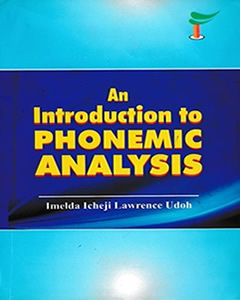AN INTRODUCTION TO PHONEMIC ANALYSIS
$5.00
There is still a very great need for many languages of the world to be reduced to writing, particularly languages spoken in Nigeria, many of which are minority languages. These minority languages attract very little attention, in the midst of a few majority languages, and many have no alphabets. Phonemic Analysis provides the techniques for writing languages. Although there are many books on the subject, some of them are quite technical for both beginners and ordinary speakers of the languages who may be interested in writing in their languages. This book, An Introduction to Phonemic Analysis, is intended to feed this need. It is meant for everyone with an interest to write in any language that had not been written before. As the name implies, it is an introductory book, and I have tried to provide enough introductory information to guide such people in the preliminary techniques for an initial description and analysis, as well as provide enough information to help them in appreciating and handling more complicated works in the area. It is my hope that this introductory book on Phonemic Analysis will be of value to students of Linguistics and any one who has the interest of writing his/her language.
I will like to thank members of my Phonemic Analysis class of the 1999/2000 class, and the Field Methods class of 2001/2002 session, both of the Department of Linguistics and Nigerian Languages, University of Uyo, for giving me the opportunity to test out some of the data, used in this book, especially the Leggbo data. I will also like to thank the 2001/2002 Field Methods class of the Department of Linguistics, University of California at Berkeley, for a most wonderful ‘field method’s experience’, especially Professor Larry Hyman, who coordinated the course.
Imelda Icheji Lawrence Udoh,
Ph.D. Uyo January, 2015.
Description
TABLE OF CONTENTS
Preface – – – – iii
Introduction – – – – v
Chapter 1 Preliminary Procedure 1
1.1 Phonemic Field Work – 1
1.2 The Data and the Informant – – 4
1.3 Recording the Data – 5
1.4 Equipment for Phonemic Analysis – 8
Chapter 2 Theoretical Constructs
for Phonemic Analysis 10
2.1 The Phoneme and Allophone – – 10
2.2 The Segment – – 18
2.3 The Tone – – 19
2.4 The Syllable – – 22
2.5 Some Premises of Phonemic Analysis – 28
Chapter 3 Some Phonological
Processes – 32
3.1 Deletion – – 33
3.2 Insertion – – 33
3.3 Assimilation – – 34
3.4 Homoganicity – – 34
3.5 Labialization – – 35
3.6 Palatalization – – 35
3.7 Weakening/Lenition – 36
3.8 Strengthening/Fortition – – 37
3.9 Vowel Harmony – 38 ii
3.10 Coalescence – – 41
3.11 Lengthening – – 42
3.12 Shortening – – 43
3.13 An analysis of Lenition and Fortition in Leggbo – – 44
Chapter 4 Analytical Procedure 50
4.1 Making a Preliminary Phonetic Chart – 50
4.2 Identifying Phonemes – 58
4.2.1 Listing Non-Suspicious Pairs – – 59
4.2.2 Minimal Pairs – 60
4.3 Identifying Allophones – 61
4.3.1 Complementary Distribution – 62
4.4 Discovering the Distribution of the Sounds – – 74
4.5 Identifying Tones – 76
4.5.1 Whistling/Humming – 76
4.5.2 Monotony Test – – 77
4.5.3 Using Frames – 80
4.6 Making a Phonemic Chart- 82
Conclusion – – – 88
Exercises – – – 90
References – – – 101
Appendices – – – 103
Prof Imelda Udoh
Questions and Answers
You are not logged in
